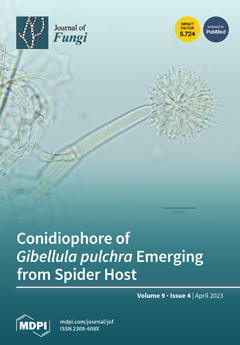For more than a century, lichens have been used as an example of dual-partner symbiosis. Recently, this has been challenged by the discovery of various basidiomycetous yeasts that coexist in multiple lichen species, among which
Cladonia lichens from Europe and the United States
[...] Read more.
For more than a century, lichens have been used as an example of dual-partner symbiosis. Recently, this has been challenged by the discovery of various basidiomycetous yeasts that coexist in multiple lichen species, among which
Cladonia lichens from Europe and the United States were discovered to be highly specifically associated with the basidiomycetous yeast of the family
Microsporomycetaceae. To verify this highly specific relationship, we investigated the diversity of basidiomycetous yeasts associated with
Cladonia rei, a widely distributed lichen in Japan, by applying two approaches: yeast isolation from the lichen thalli and meta-barcoding analysis. We obtained 42 cultures of Cystobasidiomycetous yeast which were grouped into six lineages within the family
Microsporomycetaceae. Unexpectedly, although the
cystobasidiomycetes-specific primer was used, not only the cystobasidiomycetous yeasts but species from other classes were also detected via the meta-barcoding dataset; in particular, pucciniomycetous yeasts were found at a high frequency in some samples. Further,
Halobasidium xiangyangense, which was detected in every sample with high abundance, is highly likely a generalist epiphytic fungus that has the ability to associate with
C. rei. In the pucciniomycetous group, most of the detected species belong to the scale insect-associated yeast
Septobasidium genus. In conclusion, even though
Microsporomyces species are not the only yeast group associated with
Cladonia lichen, our study demonstrated that the thalli of
Cladonia rei lichen could be a suitable habit for them.
Full article






